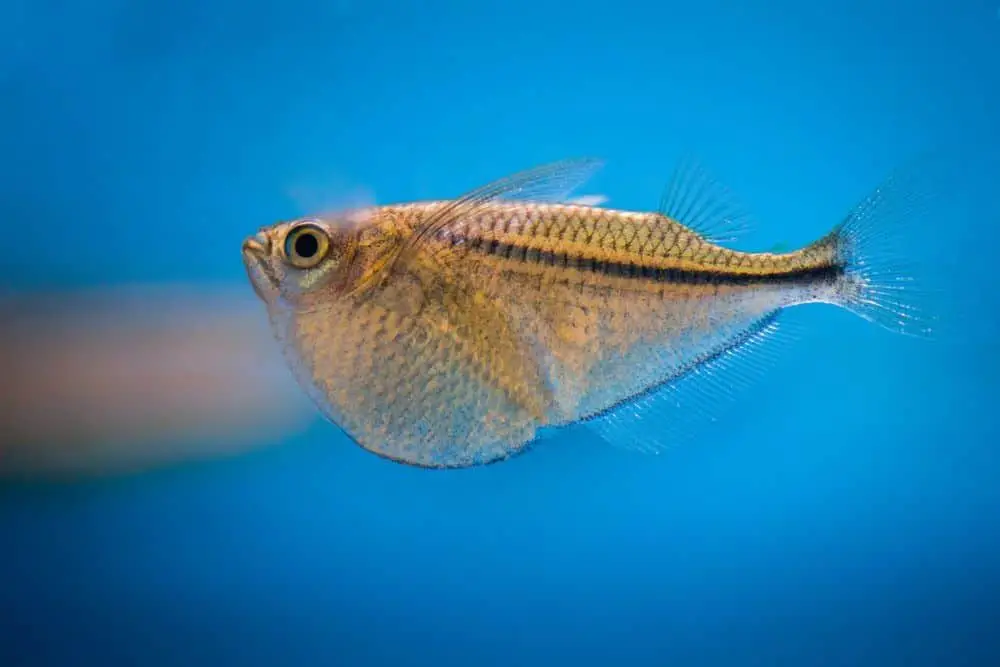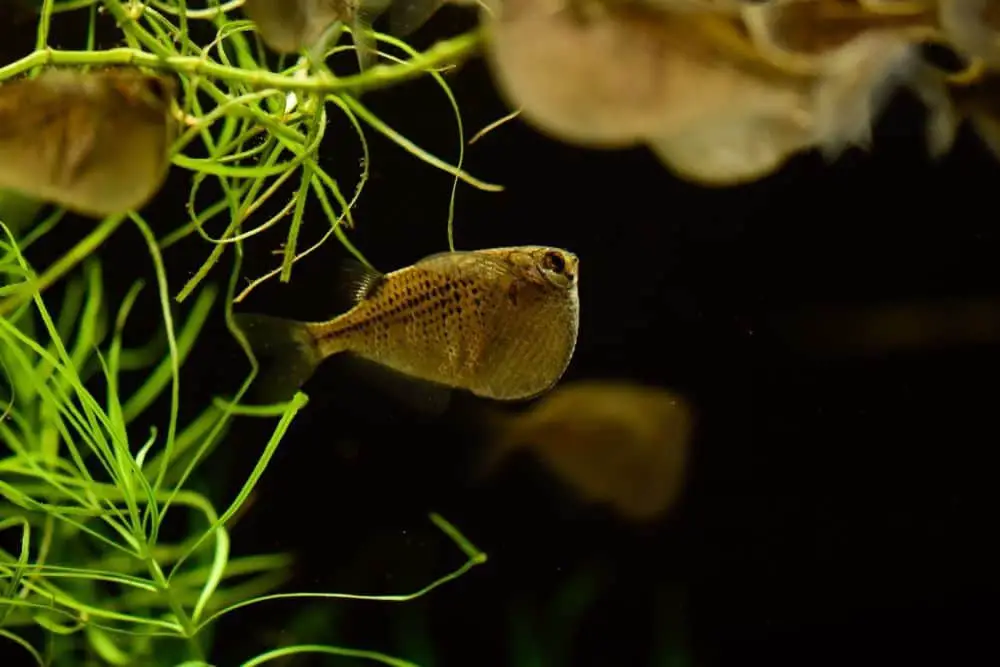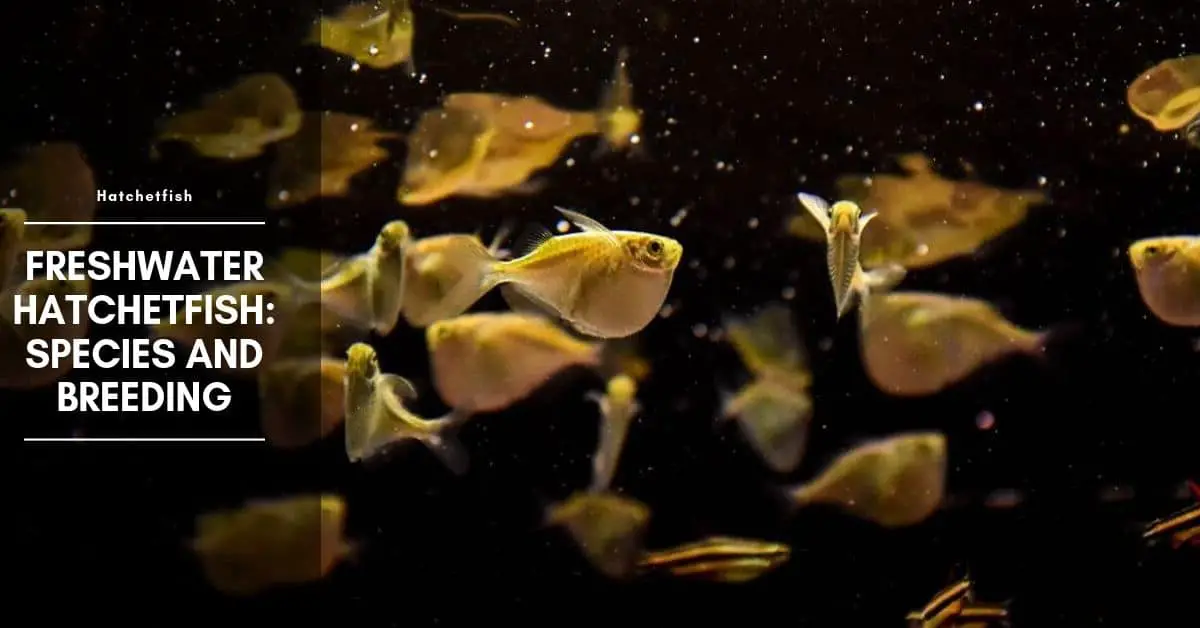The hatchetfish are placed in their own family the Gasteropelecidae. They have been called freshwater flying fish because of their habit of leaping from the water to avoid danger. The name hatchet fish comes from their unusual shape, the belly is extended downwards to form a thin blade-like keel resembling a curved hatchet.
This blade is formed into a large keeled lobe by the expansion of the lower shoulder blades along the lower surface of the thorax to support the enlarged powerful fin muscles that operate the long pectoral fins. These muscles account for up to a quarter of the weight of the fish.
The pectoral fins are held stiffly to the side of the fish and have thickened spiny leading rays. When the fish leaps out of the water the pectorals are beaten onto the surface of the water with a powerful downward stroke so that the fish passes across the surface of the water with just it’s tail and anal fin in the water and it’s keel cutting the water surface. This action is more in the nature of aquaplaning rather than real flight.
Hatchet Fish Jumping Out Of Tank
The hatchet can and does on occasion leave the water completely when it’s pectorals shape and beating action will give it a certain amount of lift, not sufficient to enable it to fly in the true sense of the word but rather they retard the effect of gravity. In many species, the base of the anal fin is marked by a dark line which when the fish is aqua-planing will be level with the water surface. The lateral line bends abruptly down in the direction of the anal fin so that when the fish is aqua-planing the end portion of the lateral line will still be immersed in water and able to function.
The lateral line is used as a method of detecting movement of other creatures in the water and the closeness of submerged objects but how effective this sense is when the pectorals are rapidly beating the water surface and creating pressure waves of interference is a matter of conjecture. It is likely, however, that the immersed posterior section of the lateral line is used as an extra sense of balance as when the fish is upright with its rear end in the water during one of its semi-aerial trips the sensory cells of the lateral line will indicate that all is well. Whereas if the fish is toppling over the uneven pressure on one side of the line in comparison with the other side will cause the fish to correct its posture.
Of course, in addition, balance is controlled by the inner ear and by the fact that light naturally always falls on the dorsal surface.
The members of the Gasteropelecidae have a wide-ranging habitat from Panama in Central America to the Rio Plata in Argentina. When purchasing specimens it is always a good idea to inquire as to the source of the import if this is known to your dealer for water temperatures can vary considerably over the family’s range. The Argentinian fish, for instance, will be used to a cooler temperature regime than species from the Amazon basin. As far as the aquarist is concerned there are three genera in the family Gasteropelecidae, Gasteropelecus, Carnegiella and Thorocharax.
All members of these genera have the same basic deep keeled hatchet shape and the same habits, some species lack the adipose fins and there are variations in color patterns but generally, all species are very similar.
Types Of Freshwater Hatchetfish
Here are few Freshwater hatchetfish species
API STRESS COAT Aquarium Water Conditioner 16-Ounce Bottle
29% OffAPI STRESS ZYME Freshwater and Saltwater Aquarium Cleaning Solution 16-Ounce Bottle
API ACCU-CLEAR Freshwater Aquarium Water Clarifier 4-Ounce Bottle
12% OffGasteropelecus sternicla – Common Hatchetfish

The Common name attached to this fish is the common hatchet fish. It has the keel common to all its group. The back is straight almost as far as the caudal peduncle where there is a slight dip to accommodate the dorsal fin. The anal fin is also set well back on the underside where the curved keel turns back towards the tail. Its native habitat is the Amazon and it’s larger southern tributaries as well as Guyana and Surinam where it grows to about 6 cm.
The color is yellowish to a yellow-green with silver reflecting scales, the color is darker on the back and paler below. On the flank is a brown to black line with pale green lines above and below it. There are also two further less distinct lines bordering the green lines. The pelvic fins are almost non-existent and all the fins are clear except for a dark band on the leading edge of the dorsal, The fish is a surface feeder and in the aquarium is particularly fond of mosquito larvae although it can be encouraged to take the better quality dry foods, As far as is known neither this species nor any of the other species are bred commercially so that all the specimens seen for sale are wild-caught fishes which are borne out by the fact that specimens in the shops are above 4 cm in length.
Reports from the wild indicate that the fish live in shoals both near the river banks and in open water so that neither single fish or pairs are suitable for the aquarium but rather a group of at least six individuals would probably be needed for a breeding attempt.
In the wild the fish leaps and aqua-planes for up to 2 meters or more when disturbed and can leap clear of the water when chased by predators. With this knowledge, it is only common sense to cover their aquarium securely. Indeed in uncovered tanks in shops, they have been observed to leap from tank to tank appearing in a tank far removed from the aquarium that they were originally placed in by the shopkeeper.
Newly acquired hatchets are often nervous and refuse food but in a quiet situation without over boisterous companions they readily adjust to aquarium conditions,
Gasteropelecus levis – Silver Hatchetfish
This species comes from the lower Amazon and grows to 6 cm. It has no adipose fin and is very similar in appearance to Common Hatchetfish. Silver Hatchetfish often has a dark blotch at the base of the dorsal and occasionally a black streak at the base of the anal fin, otherwise, classification is by dentition, fin ray counts, and scale counts. Generally, the behavior and requirements are the same as for Common Hatchetfish.
Gasteropelecus Coronatus
This 6 cm fish comes from the Peruvian Amazon, It rarely finds it’s way into the aquarium trade. The only difference from Silver Hatchetfish is in the number of teeth and many authorities including fishbase.org state that G. coronatus is simply either a local race of Silver Hatchetfish or maybe just a synonym.
Gasteropelecus Maculatus – Spotted hatchetfish
This 9 cm hatchet is rare in the aquarium world but was first introduced to Europe in 1910. This species is to be found in eastern Panama, Surinam, Venezuela, and Columbia. It is the same basic shape as the foregoing species. The ground color is gray-green to brownish-green with some specimens showing a bluish sheen. From the operculum to the caudal peduncle there is a dark stripe bordered above by a silver line and a small number of individual scales are dark giving the fish a spotted look. All the fins are colorless except the dorsal which has a dark edge.
Carnegiella Marthae – Black-winged hatchetfish

This species is found in Venezuela, Rio Negro, and Rio Orinoco basins. This species is the smallest of the aquarium hatchet fish with an adult size of 3.5 cm. The middle of the pectoral fins are darkly colored hence the common name of black-winged hatchet fish, From the gills to the tall, there is a dark stripe and above this is a silvery band. The breast and keel are edged in black, there is a row of fine spots on the flanks and there are two black bars on the cheeks. This fish has no adipose fin. It was not introduced to European aquarists until 1935.
Carnegiella strigata – Marbled hatchetfish

In the 1950s this was probably the most popular of the aquarium hatchets but today it is only seen rarely. Native to the Amazon around Iquitos and Guyana the marble hatchet grows to 4.5 cm. The ground color is a yellow-green showing silver by reflected light, the back is dark olive with darker spots and stripes.
There is a dark stripe from the operculum to the caudal peduncle with a silver margin to the upper side. There are three irregularly shaped black bars on the keel. The fins are colorless and the adipose is absent. It has been suggested that there are two sub-species C.strigata strigata and C.strigata vesca. The fish was originally introduced to Europe in 1912. Once established these hatchets are hardy and greedy eaters.
Carnegiella Myersi – Pygmy Hatchetfish
This species comes from the Rio Ucayali in Bolivia and the Peruvian Amazon. It first came to Europe in 1957 but is now rarely imported. At 2.5 cm it is the smallest of the hatchets.
Thoracocharax Securis – Giant hatchetfish
This species from the fast-flowing rivers of South America it grows to 9 cm and is rarely seen by the fish keeper although it was first introduced into Europe in 1910.
The ground color is a yellow-brown to pale olive and silver by reflected light. From the gill covers to the tall is a broad line which shows as a blue or green by reflected light. As the fish ages, the body deepens until it’s depth and length are almost the same. The pectorals on this species are probably the longest of all the species that have been kept in the aquarium stretching back to well below the anal fin.
Thoracocharax Stellatus – Spotfin Hatchetfish
This species is similar to Giant hatchetfish and ranges from Central Brazil to Argentina. The differences as far as the aquarist are concerned are that the pectorals are shorter, there is a black stripe on the leading edge of the dorsal and the keel is not so deep as in Giant hatchetfish.
Breeding
Several of the hatchets have been bred in captivity. Silver Hatchetfish is reported as one success where the male drives the female into fine leaf plants to deposit her eggs. In the wild, they spawn amongst the fine roots of plants along the river banks.
The male drives the female by swimming alongside her not by a chasing motion as is common in many fish. Although single pairs have been spawned in aquaria it is to be expected that in the wild communal spanning is the norm. The eggs hatch in about thirty hours and the rearing and care is the same as you would give to the common tetras.
The hatchets are interesting additions to your collection and providing they are given a quiet environment when first introduced they usually settle in well. Surprisingly for a fish primarily from the Amazon area, they are not particularly concerned about water hardness. I have kept them in both London tap water and Essex tap water but for breeding softer water is probably preferable.
They are peaceful but like most other fish if it goes in the mouth it’s food be it mosquito larvae or your best livebearer fry. They rarely take food from the lower levels of the tank and never in my experience pick up food from the bottom of the aquarium so care is needed by siphoning or the inclusion of catfish to make sure missed particles of food do not foul the gravel. It should never be forgotten that it is their nature to leap particularly when startled so a secure cover is needed on their aquarium.

Hi, my name is Sean, and I’m the primary writer on the site. I’m blogging mostly about freshwater and saltwater aquariums, fish, invertebrates, and plants. I’m experienced in the fishkeeping hobby for many years. Over the years I have kept many tanks, and have recently begun getting more serious in wanting to become a professional aquarist. All my knowledge comes from experience and reading forums and a lot of informative sites. In pursuit of becoming a professional, I also want to inspire as many people as I can to pick up this hobby and keep the public interest growing.
Read more about Sean.
Please join also my Facebook group.




















